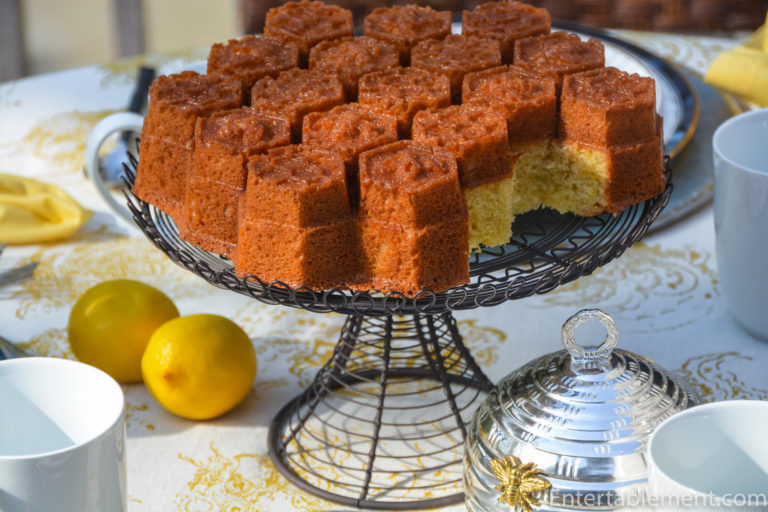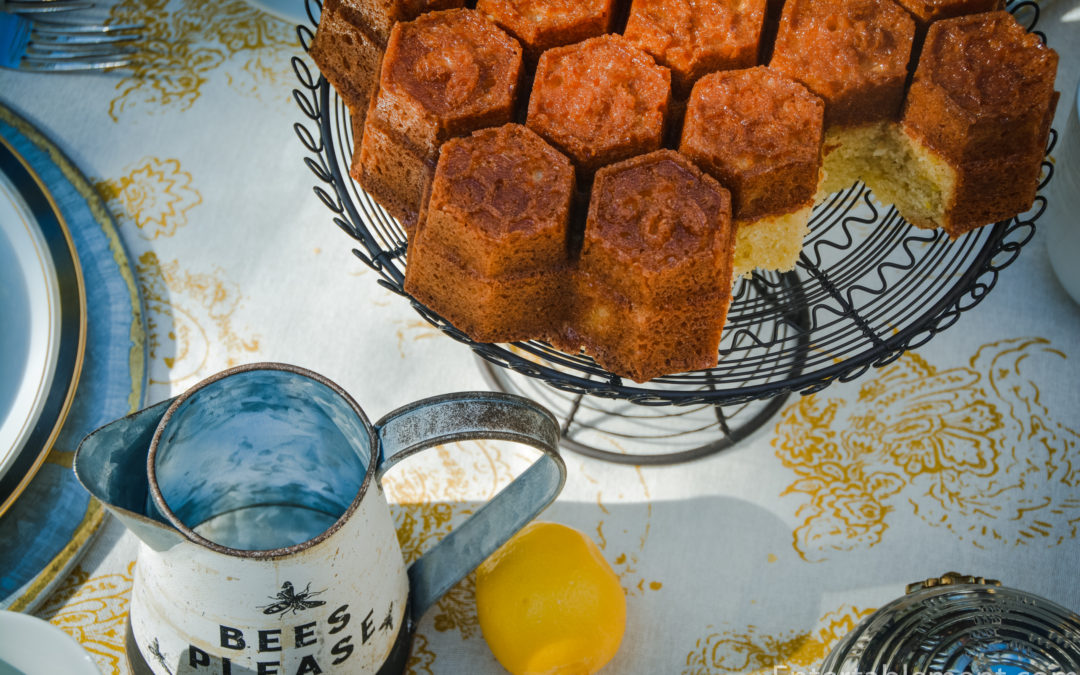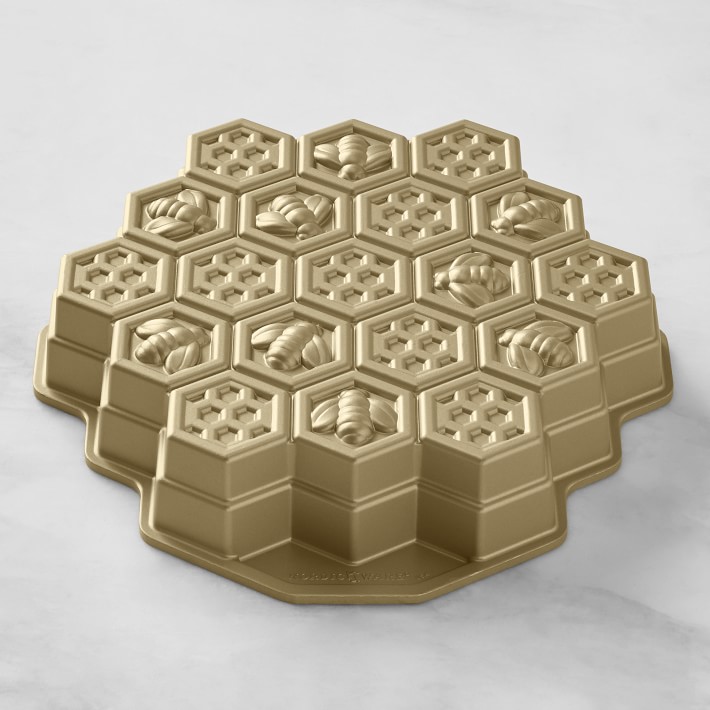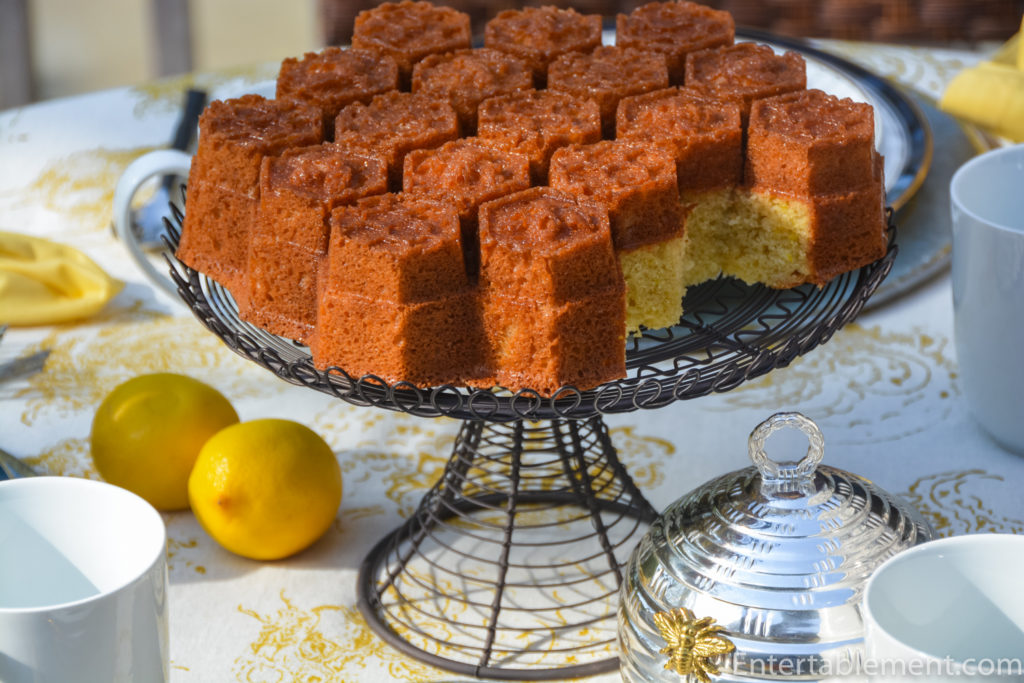The honeycomb pan for this cake has been lurking in my cake pan cupboard for a couple of years, waiting for its debut. Once the Bee plate table started to percolate, out it came. But first I had to do some research on the ultimate cake batter for this tricky pan.
My granddaughter Maddie loves pound cake, especially when they’re baked in fun pans. We had a blast making a snowman cake last Christmas, though I discovered that the recipe needed some tweaking. The snowman pan is quite deep and the outside of the cake baked before the middle, which was problematic, to say the least. This is likely why the pan has been discontinued and can be had for $5 on e-Bay.
Our choice seemed to be either keep baking until the cake dried out and the outside became rock hard or remove some unbaked batter, leaving a shallow hollow in the middle of each half and finish them in the oven, which is what we elected to do, The two halves had to be stuck together with icing and the dodgy middle kept threatening to subside, collapsing the snowman in true melting Frosty style. The cake was good; the presentation was not what I’d hoped for, and which is so confidently and lovingly displayed on Williams Sonoma’s recipe site.
Thus I’ve been on a quest to perfect the cake recipe for moulds with lots of contortions, such as Nordicware pans present. There are dozens of shaped pans, each more delightful than their predecessor. I was particularly intrigued by the “pull apart” nature of the honeycomb pan.
The cake must be buttery, with a neutral flavour that can be enhanced with the addition of, say, citrus, as in this case. Light enough to bake evenly and sturdy enough to maintain its shape in all the nooks and crannies.
The recipe that came with this pan contained sour cream, which is not typically featured in pound cake; I substituted yoghurt. The result was lighter and more spongey than a typical bundt cake. I lightened up on the lemon zest called for in the original recipe and added some vanilla. I also baked it at 325° F, a lower than normal temperature for cake baking.
Verdict: delicious. Buttery, moist, with just enough lemon and a touch of sweetness from the glaze.
The shallow, flat profile of the 10-cup pan also helped to keep the cake moist, as it bakes more evenly than a typical deep bundt pan, though in about the same amount of time.
I think we have a winner here. I’m eager to revisit the Snowman pan. Maddie – get your apron ready. We’re going to do some baking!
Print
Lemon Honeycomb Cake
This buttery bundt-style cake has a light, spongey texture with hints of lemon and a touch of sweetness. Delicious!
Ingredients
For the cake:
- 360 g or 3 c cake flour
- 1½ tsp baking powder
- 1 tsp baking soda
- ¼ tsp salt
- 226 g or 1 c butter, softened
- 300 g or 1½ c sugar
- 4 large eggs
- 245 g or 1 c yoghurt
- 1 tbsp grated lemon rind
- 1 tsp vanilla
For the glaze:
- 63 g or 3 tbsp honey
- 54 g or 1 c confectioners’ sugar
- 2 tbsp lemon juice
Instructions
Make the cake:
- Position a rack in the centre of the oven and heat the oven to 325°F. Spray pan with high-quality baking spray containing flour (I used Bak Klene).
- In a small bowl, whisk together the flour, baking powder, baking soda, and salt until evenly combined.
- In the bowl of a stand mixer fitted with the paddle attachment, beat the butter and the sugar at medium speed until light and fluffy (about 2 minutes).
- With the mixer running on medium-low speed, add the eggs, one at a time, mixing for at least 20 seconds after each addition, and scraping down the bowl and paddle occasionally. Add the yoghurt and mix until combined.
- With the mixer running on the lowest speed, add the flour mixture in two portions and mix until just combined.
- Scrape the bowl one last time, add the lemon zest and vanilla extract and mix at medium speed until the batter is smooth and fluffy (20 to 30 seconds).
- Scrape the batter into the prepared pan and spread it evenly. Tap the pan firmly against the counter to dislodge trapped air (put a cutting board down to prevent the counter getting damaged).
- Bake until golden brown and a toothpick inserted in the centre comes out with only moist crumbs clinging to it (45 to 55 minutes).
- Cool in the pan for 10 to 15 minutes and then invert onto a wire rack to cool completely. The cake will keep at room temperature for 3 days.
Make the glaze:
- Combine the ingredients in a small bowl and heat in the microwave until the sugar is dissolved and the mixture is warm (60-90 seconds). Brush on the cake while it’s still warm.
I’m sharing this post with Between Naps on the Porch.












Dear Helen,
What a pretty and interesting looking cake…I imagine all sorts of recipes would work in this because of its regular (shallow) shape. I haven’t had a bundt pan in years–gave them to the Salvation Army because it’s just not nice to work their depth and volume. Are we going to get more of a look at the table??
We celebrated end of quarantine today; the valley has not one corona illness. We intend to mark Ascension by hiking to an Alpine restaurant high up in the Silbertal, which is finally open. I’ve just about exhausted my usual repertoire of recipes, setting a nice table nightly…no pizza here! The weather is absolutely gorgeous,–cool, with breezes and lots of rain for the garden. Had at the lilacs today… IRIS!
Hi Beatrice,
I think you’re right that the pan would work for all manner of cakes, including more dense ones. King Arthur Flour even had a recipe for buns, which could be interesting.
The table is in a separate post which has been posted on the site; I’ve put a link into the recipe post, too. Sorry – I should have been clearer.
Congratulations on coming out of quarantine. You must be feeling quite a bit more settled with the journey behind you, and knowing you’re in one place for the summer. Things are slowly starting to open here.
Our big lilac seems to have taken a beating over the winter, for whatever reason. No blooms for us this year – it’s largely dead. It’s now had a very severe cutting back and we will keep our fingers crossed for the bit that remains. If it doesn’t make it, I’ll have to replace it. It seems symbolic of the year, somehow.
Oh!!! Room for Madame Lemoine! The best lilac in the world.
Madame Lemoine X 2 are already planted and we are awaiting her bounty. Probably not this year, though. Lots of leaves, but still settling in – both locations. I do still want a “common” lilac, though. Here’s hoping our oldie but goodie has a comeback.
Okay, so second time I made this cake, it came out PERFECT. First time, however, I both overcooked it, and under greased my pan lol. So after spending like 30 mins cleaning all the cake from the crevices of this pan, I tried again and used wilton cake release. Lesson learned, use proper greasing methods. All completely my fault and no fault of this recipe. Which is divine!! Such great flavour, great crumb, icing or glaze is SO good. Made this for Beltane and as an offering to the Fae. I’m sure they loved it! Thank you! Will for sure make this again!
★★★★★
This recipe worked perfectly with this pan. I bought it in the “seconds” section at the Nordic Ware factory store. There was no packaging and a few scratches on the sides of some of the sections so I was scared that it would be difficult to get the cake out intact. I used a brush to apply Wilton cake release (the kind with the flip-top dispenser since I didn’t have spray) to every crevice and removed it from the pan 12 minutes after taking it out of the oven. The patterns were well-defined and there were minimal crumbs left in the pan, which made it easy to clean. The cake is sturdy like corn bread but smooth, without the grainy, mealy texture of some corn breads. Thanks for this great recipe! It’s going to be a staple in my house from now on.
★★★★★
This looks so good! What a great cake to make for company in the summer!
Thanks, Susanne. It’s so easy to make! Enjoy.
Thanks for sharing! Does it keep long?
It’s pretty moist, Vanessa, so it is still delicious after a few days. It also freezes well if you want to save some for later.